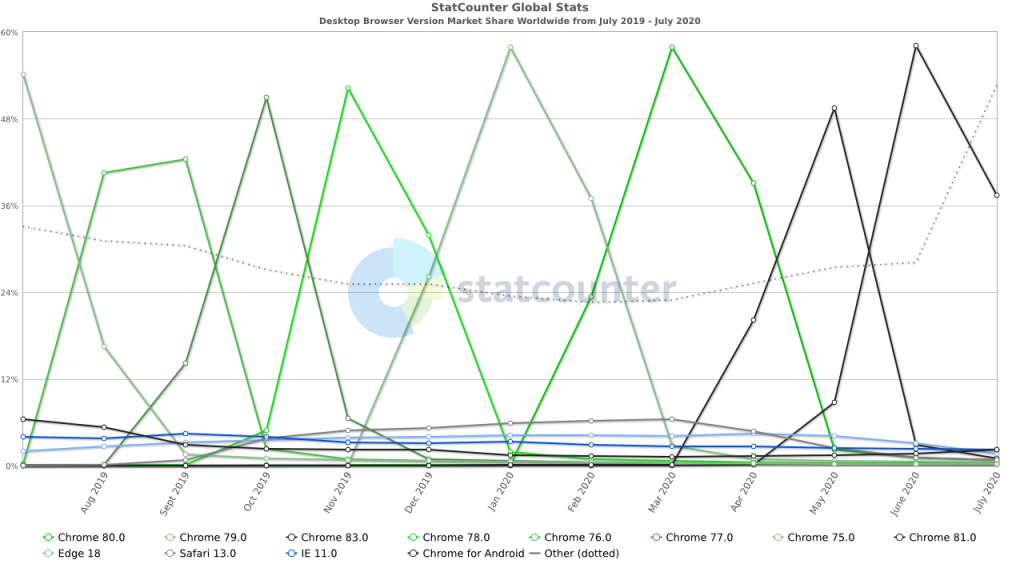Is the future less IDs or ID-less?
August 28, 2020
Let’s get one thing straight from the off: don’t listen to the doomsayers, advertising IDs ARE NOT about to disappear.
Now that both Google and Apple have taken strong positions around cookies and IDFA respectively, ad targeting via user IDs seems endangered and this has led to a mass freak-out across the entire ad tech ecosystem. What is now clear, however, is that some of these capabilities will survive, others will disappear. What we’re left with will require more ideas with less ID’s and in the end, should lead to a better, more sustainable future for ad targeting.
Let’s begin with what won’t disappear and a dose of realism. Next time you visit your parents, check out their computer, phone or tablet and look at which browser version or OS they’re running. You may not realize, but most people don’t update their browser very quickly. Some (like your parents) don’t ever update. Take a look at this graph from Stat Counter:

and this breakdown of usage as of July 2020:

The same thing applies to iOS, Windows and Android.
While you’re at your parents place, maybe help them out a little bit. They love you too. No doubt their OS is the reason why their apps “work funny”.
At the same time, what we’ll soon be referring to as ‘old-skool’ IDs will become scarce. In a few years time, I’d estimate that only 5% will remain.
Which brings us to the possibilities for ‘new web targeting’. While companies such as Liveramp or ID5 are already working on interesting approaches to the problem, some users will also give consent to apps. The Ad industry will need to figure out new ways to understand user behavior, and go beyond the simple/goto/dumb answer of contextual targeting we hear everywhere. This is an easy out propagated by opportunists; I say this as the CEO of one of the contextual targeting leaders in France, so I’m not doing myself any favors. All the while, whatever solutions there are will need to be more respectful of privacy than the ugly, brute-force processing of individual IDs at scale.
The signals we see across the industry seem to indicate that we’ll soon be entering the ‘logged-in’ era of web browsing. Elegant, seamless, persistent one-click logins could become the norm, with publishers jumping on the bandwagon as soon as they recognize the revenue opportunity. The era of persistent logins/IDs will allow more granular and intelligent browsing, as well better behavioral – and therefore targeting – data.
By the way, login remains one of the most frustrating online experiences and is ripe for disruption.
The solution that exists to the problem of scale can be found by looking back in time, through the advertising playbook, at user panels. This approach worked through basic data (with mixed results) for TV, print and radio for years. With the ability of online advertising to apply precise behavioral data, through real technology applied by real technological minds, the results can be insanely good. It will open up new ways of data exploration, targeting and extrapolation. But this will cost advertisers more money and in the short-term, performance may suffer. If basic data was applied into the future, this would continue to be the case. But with more precise data and better technology, the same performance will probably return within a year, and may even be better than it ever was.
Of course, what I’m describing will be the case for most of Adtech… but not all. For us at KMTX, the performance is already there. We’ve been preparing for this exact situation for some time and the results are truly mind-blowing. Our approach is working with less than 1% of our cookie base and it is the most exciting thing I’ve ever seen in Adtech, and I’ve seen plenty.
Therefore, even with less IDs, between the old way of doing things and logged in data, we have more than enough to do our job, and do it very, very well. Because less IDs don’t mean we’ll be blind. Just that we need new ideas. And new glasses.
